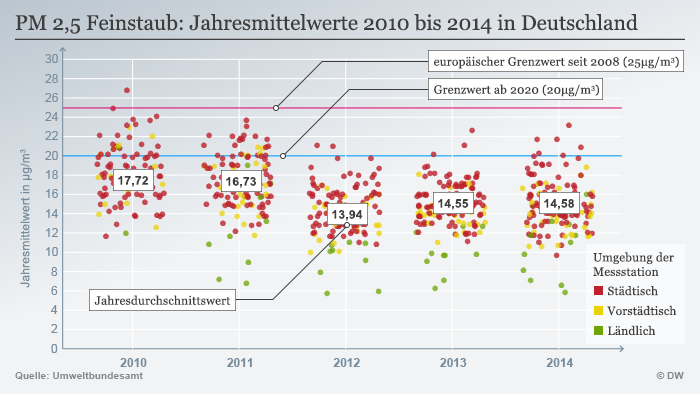Environmental protection
Thick air in the East
The Bundesumweltamt regularly publishes data on particulate matter emissions in Germany. How bad is the situation? How clean is our air? We have the data clutter in order. Here’s how it came out.

At the latest after the VW-Abgasskandal and
Smog-Alarm in Stuttgart
At the beginning of the year is the issue of particulate matter is also with us in Germany. Under observation, in particular the fine particulate matter PM2,5. With just a diameter of 2.5 micrometers, they can be up in the bronchi and alveoli penetrate.
Depending on the size and depth of penetration of the particles, the respiratory system properly damage can be done. It can cause harmless illnesses such as cough, mucous membrane irritation and local inflammation in the trachea. But also to massive complaints, for example Asthma or an increased build-up of plaque in the blood vessels.
Since 2008, therefore applies to the protection of human health in Europe a limit of 25 micrograms (µg) of particulate matter per cubic meter of air on average. Since 2015 is this value binding.
From 2020 the limit once again be tightened. A cubic metre of air annual mean of not more than 20 µg PM2,5-fine particulate matter.
The Federal environment Agency published since 2010 regularly the PM2,5 measurement of, by now, 170 monitoring stations in the whole of Germany. This record, both on Land and in the city, the PM2,5-particulate air pollution.

Sorts and filters to get the many data, it is clear that in Germany the limit value of 25 µg per cubic meter only once been exceeded. So in 2010, was at the Station Neckartor in Stuttgart, a value of 27 µg in the average measured.
Overall, in Germany, a decline in particulate matter visible, even if this Trend for 2013 is stagnant. In addition, it is visible – what you already suspect -that the loading with particles in urban and suburban areas is higher than in rural areas.
The 2020 limit value of 20 µg PM2,5 would need currently in particular cities in East Germany, fear. In the year 2014 were in Rostock, Germany, annual mean of 23 µg measured, in Halle and Berlin of 22 µg.
In particular, Berlin is still not fit for the year 2020. Until then, stay in the German capital, however, is still four years.
Added: In comparison to the Smog capitals, such as #link:18925863:Beijing or New Delhi, it seems the particulate matter Problem in Germany, only once, ridiculously low. So was the monthly average in the Indian capital since 2013 never below 50 micrograms per cubic metre. At the beginning of the new year, the figure was even alarming 250 micrograms per cubic metre – a ten-fold Exceedance of the European limit value.
At the beginning of may the Federal environment Agency the data for 2015 post. Then, we will once again have a look at the current development time.


